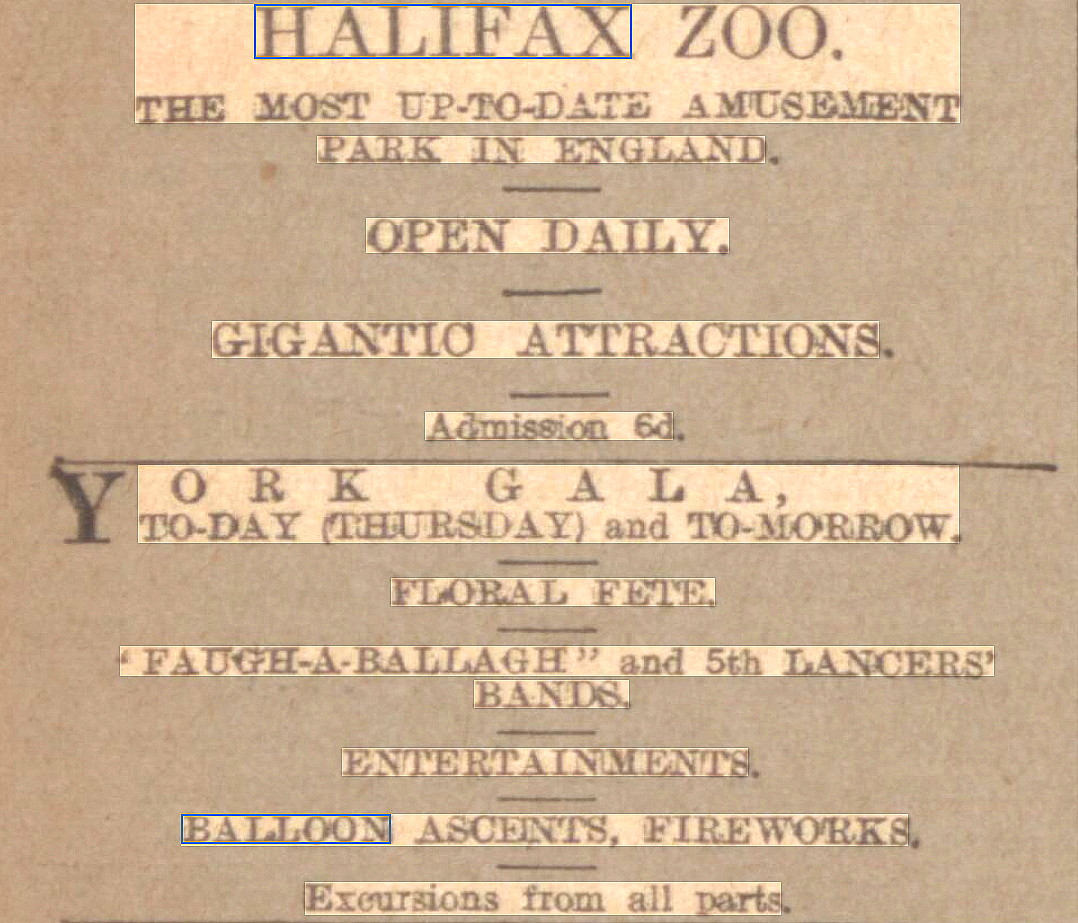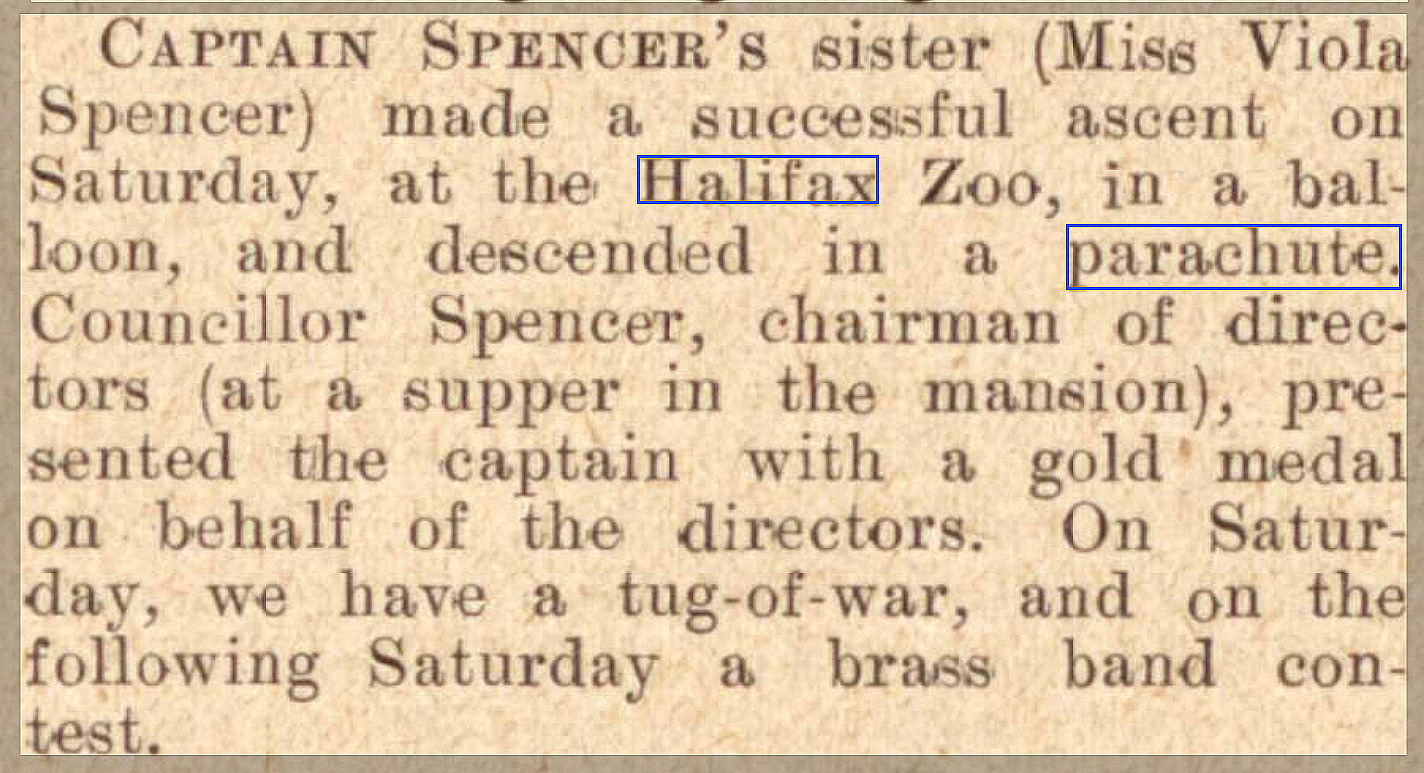Halifax flying sites
Note: This map shows the location of Halifax West End Golf Club
HALIFAX see also LIGHTCLIFFE
HALIFAX RACECOURSE: Temporary flying site (Now the Halifax West End Golf Club)
Note: This picture was obtained from Google Earth ©
Location: About 2nm W of Halifax town centre
THE FIRST MENTION
The first mention of aircraft being based here was over the Xmas period in 1909. They were on display each day and as the Notice states it was planned that the aircraft would fly from the race course to the zoo each afternoon until the 8th January. Balloon ascents were planned to take place from the zoo.
Of the three aircraft attending one soon became unservicable and we do not know if the two remaining managed to fly each day? It was only a short distance from the race course to the zoo, the latter being roughly 3nm to the southeast, and presumably Halifax in those days was nowhere as built up as it is today? So, I imagine that low level flights were entirely possible over fairly open country.
NOTES: On Saturday the 11th June 1910, Claude Grahame-White gave a flying demonstration taking-off in winds estimated to be around 20 to 30mph. This was a very high wind speed for flying in those days, (in fact it still is today for many light aircraft), and clearly shows why Grahame-White was regarded even amongst his fellow pilots as being a “plucky” flyer. The main purpose of this flight, it seems, was to fly across to the Zoo and circle it - a distance of around three to four miles.
However, without much if any doubt, the wind speeds were much lower as the Henri Farman he was using, almost certainly a Farman III (?), had a maximum speed of just 37mph.
It appears he made a very short flight the previous evening. He and his aeroplane had arrived from London by train, which was quite normal in those days, and they departed to same way - but not without mishap when the wagon transporting the aeroplane collapsed, it being carried to the station by an ad-hoc team of 'burly Halifax men'.
It had been planned for Grahame-White to give exhibition flights on the following Monday and Tuesday but the winds were forecast to be much stronger, and presumably blustery in that area especially. This usually meant that the lulls between gusts would have far exceeded the limits between flat-out speed and stalling.
Before WW1 racecourses were considered ideal venues to conduct exhibition flights, which then attracted huge crowds. We need to remember that in those days very few people had seen an aeroplane, let alone one actually flying. It was also a great opportunity to make a great deal of money for all concerned, not least the aviator, as racecourses offered a near perfect venue, with grandstands and organisers well used to handling large crowds.
It is said that Grahame-White was offered £1,000 to make these exhibitions of flight. That equates to about £78,000 today. I wonder if he received the full fee after the project was curtailed?
In his excellent book RAF Hendon Andrew Renwick records that during his short stay here Grahame-White visited the Northern Aero Syndicate in Bradford.
Typically, along the way of my research I have found the Grahame-White name, (one of the most famous British aviators prior to WW1) , spelt in a variety of ways, especially the second part of his surname.
HALIFAX ZOO - CHEVIN EDGE : Balloon ascent venue
Note: This picture was obtained from Google Earth ©
Location: Just E of the A629, about1.5nm S of Halifax town centre
NOTES: It appears that in 1909, shortly after the Zoo and Amusement Park opened, hot air balloon 'experiments' took place. I have found one record of a Captain Spencer ascending in a balloon to make a parachute jump on the 12th of June. The parachute was dangling beneath the balloon like a 'carelessly folded umbrella' but it worked. Freed from the weight of its passenger and parachute it appears the balloon then up-ended and crashed.
Captain Spencer was then driven back to the Zoo to receive the acclaim of the crowd.
A search on the inter-web will reveal pictures of the utterly inhumane tiny enclosures these animals, up to the size of lions, were kept in. But I suppose, considering the conditions most factory workers lived in and worked in, they probably considered these tiny enclosures very spacious.
A MICHAEL T HOLDER GALLERY
Noticing this listing, Mike Holder, a great friend of this 'Guide', kindly took it upon himself to see what information in the press, and maps, might be available. As can be seen below there is quite a lot, which includes three mentions of this location being used in 1909 for balloon ascents, one in June, another in July and the other in December.
Article One was published in the Leeds Mercury on the 17th June 1909. Article Two regarding the parachute descent on the 3rd July was published in the Halifax Daily Guardian on the 5th July 1909.
The short article about the parachute descent made by Miss Viola Spencer on the 10th July was published in the Music Hall and Theatre Review on the 15th July 1909. The advert was placed in the Bradford Daily Telegraph on the 23rd December 1909.
Article Three was published in the Shipley Times and Express on the 24th December as was the Notice on the 31st December 1909.
NOTES: The Article Three and the Notice appear to be at variance? It would appear that three machines were on exhibition, but only two ready to give exhibtions of flying, as displays were usually called in those days.
To date no information has been discovered as to whether or not any aeroplane flying actually took place? If anybody can kindly offer advice, this will be much appreciated. The aircraft were based at the nearby racecourse and advertised to fly each day to the zoo in the afternoons until the 8th of January.
They would not of course be landing at the zoo. It was only a relatively short distance, the race course being roughly 3nm to the north west, and could have been flown at low level. Presumably Halifax was nowhere near as built up in those days (?) and, if so, the flights could be undertaken over fairly open country. But, was the early January weather kind enough?
The mention of Miss Viola Spencer making a parachute jump serves to remind me that, in England at least, the advent of aviation, (ballooning at first of course), was seized upon by many women as being a new opportunity for them to assert their sense of being independent enough to engage in what was generally percieved as being a very risky business to partake in. Usually as passengers though.
History has given us many examples of strong willed women, throughout the ages, being quite capable of attaining positions of power and influence. But, in Victorian England at least, it was very much a male dominated patriachal society. Perhaps the notable exception of achieving public acclaim being mostly in the entertainment sphere.
We'd love to hear from you, so please scroll down to leave a comment!
Leave a comment ...
Copyright (c) UK Airfield Guide






























